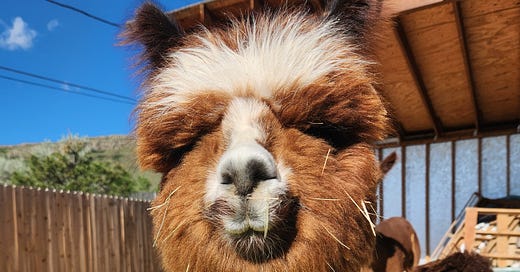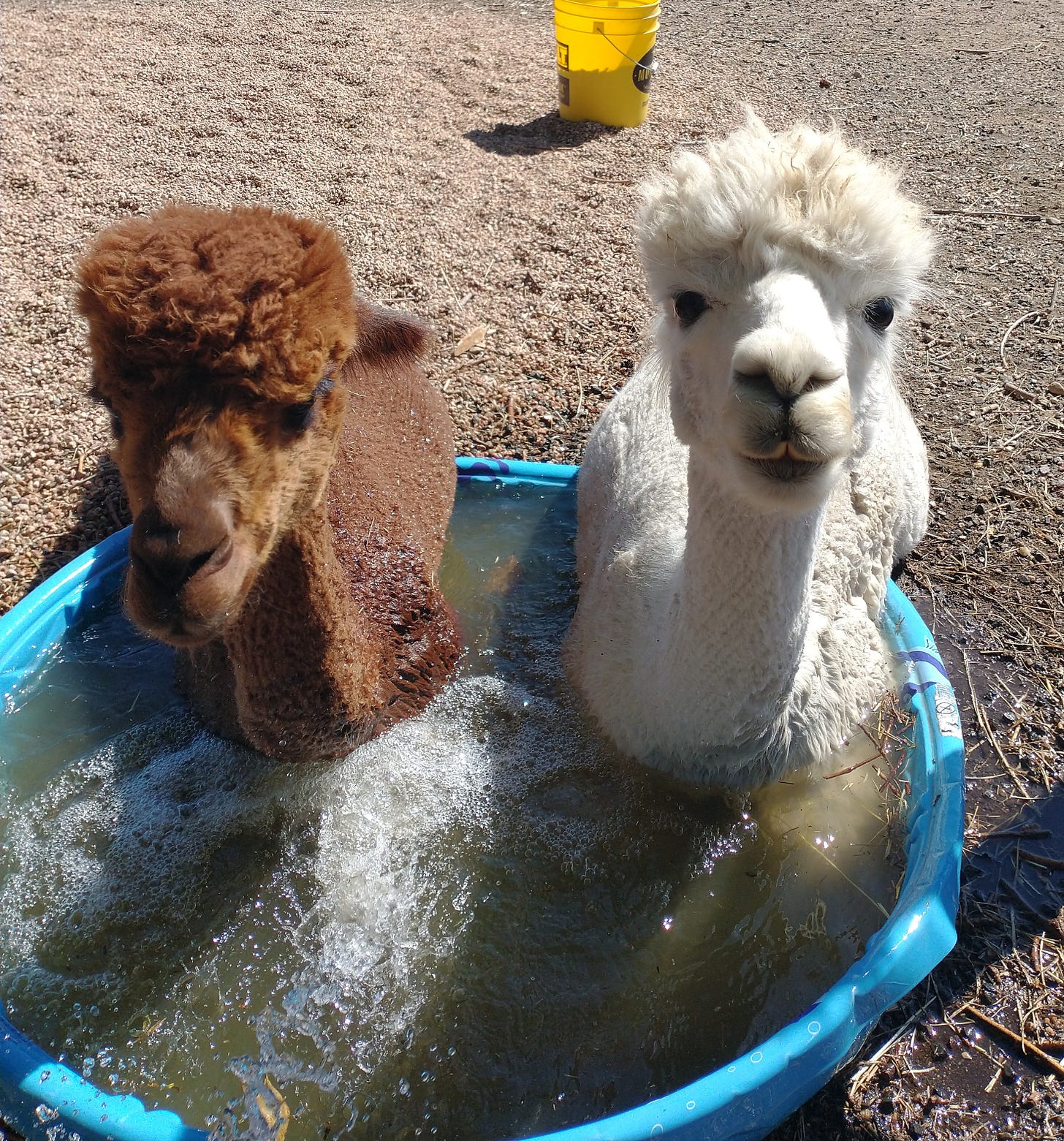Bees are famously democratic. When they swarm, scout bees come back from seeking a new home and dance to tell the colony what they found. The other bees join the dance of the scout who they think they should follow. There’s a whole book about it: Honeybee Democracy.
I think sometimes about what policies my bees would care about if they took part in human democracy. Certainly, they would want more strict regulation of pesticides and pollution. If they had a word for it, they would also be concerned about the impacts of climate change on their ability to survive year to year: extreme heat, flood, wildfire, and droughts that damage their sources of forage—both wild and agricultural.
Bees are not the only creatures I take care of who are impacted by climate change. As I have worked on postcarding campaigns for the Environmental Voter Project over the last couple of years, I have often thought about the reasons why our alpacas would want us to be environmental voters, too.
Climate Change and Alpacas
The major ways that a changing climate impacts alpacas are through shifts in weather patterns and extreme temperatures and reductions in available food. As we think long-term for our small alpaca farm, we wonder if we might be better off moving to an ecosystem where more reliable rainfall will keep grass growing and hay prices lower. Last year, drought in Nebraska made the hay prices here rise considerably. Other places in the U.S. are projected to have more intense heatwaves in the future, though, and heat stress is also hard on alpacas.
In the Andes, where alpacas are indigenous and also a way of life for many people, climate change is already having big impacts on the animals and those who farm them.
According to Lucien Chauvin, writing for National Geographic, "Climate change in the Andes has rewritten weather patterns in ways that have affected alpacas at every stage of life—from increasing mortality of newborns to shrinking grasslands where herds feed. Abrupt changes in precipitation, as well as ice melt as glaciers retreat, are wreaking havoc on both alpacas and the communities that raise them."
The retreat of glaciers, impacting the flow of water, has made it hard for alpacas to find enough to graze, while sudden cold snaps breaking into the normally moderate weather of the Andes have also killed alpacas. Extremes of heat and cold have caused issues in alpaca reproduction, a rise in stillbirths, and mortality in herds who are not used to the stress of the weather.
A study by the National Institute for the Study of Glaciers and Mountain Ecosystems found that the Andean Cordillera in Peru has lost half of its glaciers in the last 50 years. As glaciers recede, rivers do too and, although alpacas can subsist on a pretty lean diet, the lack of available grazing due to drought could seriously hinder the survival of the alpaca industry in the Andes. It’s heartbreaking to think of the consequences for the animals and the people who both care for them and depend on them.
Adaptations are possible, and people are starting to keep alpacas at lower altitudes, but the stress also has an impact on the quality of the fleece, which can grow coarser with these changes. Alpaca fleece grown in these conditions is usually still soft and desirable, but not as good for very finespun traditional textiles, a staple of the industry.
How to Avoid Heat Stress in Alpacas
For alpaca farmers, there are many ways to help with heat stress.
Emotional or high-impact events such as birth or weaning should be avoided during the hottest time of the year. For some, that may require adjusting a breeding schedule so that more crias are born during the spring or early fall. (Fall babies do sometimes need zinc supplements.)
Our alpacas are afraid of the fan we got for the barn, but many ranchers use fans to keep their barns cool. A side benefit is it also deters flies.
Provide shade.
Alpacas love to dip in cool water. Our girls line up by their pool, waiting to be hosed down whenever I go outside to water the plants. Soaking in water for too long, however, can damage the fleece.
Shearing should be scheduled before the hottest part of the year. This year, the shearing crew told us that they visited some places where people were shearing every other year to cut costs. That is dangerous. By the time our girls are sheared, they have fleece three-inches deep on their backs. Imagine that in 90-degree weather. Times two. Annual shearing is essential for the health of the animals.
Alpacas and Sustainability
So, if they were looped into the conversation, alpacas would care very much about environmental policy. They would also practice what they preach as they are environmentally-friendly livestock.
They are efficient grass-to-fluff pipelines, eating relatively little for their body weight and requiring less water.
Although they do tend to drylot pastures by grazing, when land is available to rotate them on different pastures, they are easy on the terrain because they have soft feet and nibble the top of plants rather than pulling them up by the root. That helps with soil erosion, too.
Their manure is a great fertilizer because it is relatively low in nitrogen and will not burn plants like fresh cow manure will. (Fun fact: you can buy our alpaca “beans” for your garden for $0.50 a pound. Local pickup only.) They also produce less methane than other livestock.
Alpacas do not produce lanolin, so their fiber can be processed without harsh chemicals.
Plus, some farmers in the UK have begun grazing alpacas alongside other livestock like sheep so they can eat and therefore control invasive species in the pastures. After our experience with the alpacas eliminating curly dock on their side of the fence, I believe this strategy would be effective.
Get Involved
There’s a sentiment that floats around a lot in environmentalist spaces online: “People ask why I care so much about nature. I live there.” Changes in the weather impact the animals and insects, but they also impact us. So, yes, the alpacas would want you to be an environmental voter, but you don’t have to do it for them. Do it for yourself, your kids, or your neighbors. Even the annoying ones.
Here are some ways to get started:
Today is National Voter Registration Day! Register to vote or check to make sure your voter registration is still active. Learn your state’s Voter ID rules, too. They have changed in many places. Make a plan for when and where you will vote, early if possible.
Join Citizens’ Climate Lobby and/or volunteer with the Environmental Voter Project
Research the candidates up and down your ballot to see where they stand on climate change and environmental issues specific to your community like water management, open spaces, insurance policy, pollution, etc. I usually go to candidate websites, but Ballotpedia is useful too.
Stay informed without a doomscroll by checking out the newsletter Fix The News and the podcast Outrage Optimism.
Learn about home electrification with Rewiring America. They can help you get those Inflation Reduction Act rebates too.
Collective action is essential. We can’t make the necessary changes unless we do so together on a large scale, putting pressure on governments and industries. But there are still a lot of little things to be done, too. Consume less. Go outside and love the land you’re on. Talk to your neighbors.
And VOTE, BABY, VOTE.




